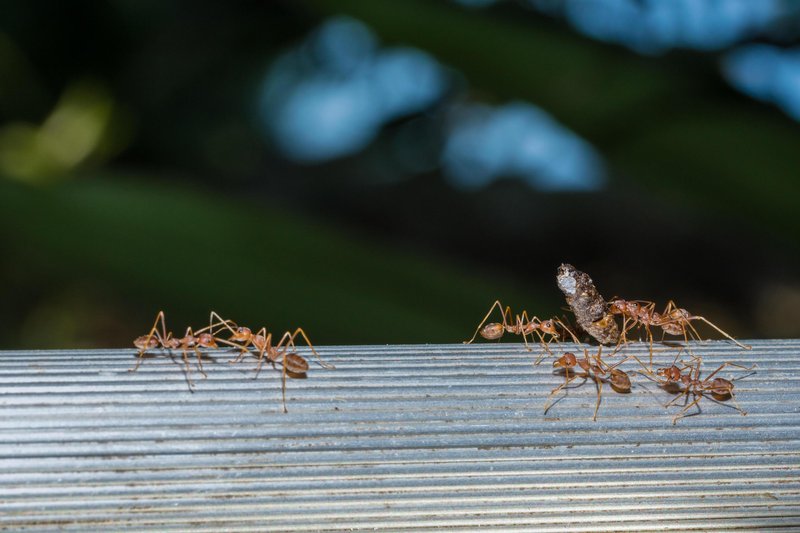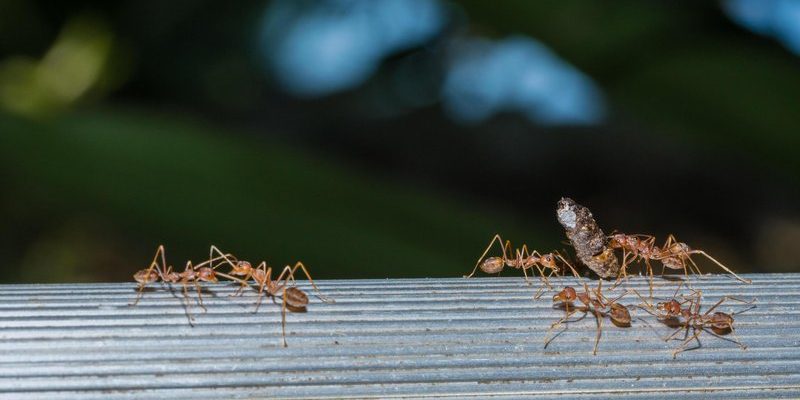
Introduction to Red Ants
Red ants are some of the most intriguing creatures you’ll encounter outdoors. With their fiery color and tenacious nature, they often capture our attention. These ants belong to various genera, but the most notorious among them is the fire ant. Their name comes from their bright red color and their painful sting, which can feel like a burn—hence “fire.” But there’s more to them than just their sting!
You might be wondering about their role in the ecosystem or how they differ from other ant species. Red ants play a significant part in soil aeration and seed dispersal. They’re social insects with complex behaviors, giving us a glimpse into the fascinating world of cooperative living. Understanding red ants helps us appreciate their importance and the balance they maintain in nature.
Physical Characteristics of Red Ants
Red ants are relatively small insects, typically measuring between 1/8 to 1/2 inch in length. Their vibrant color ranges from deep mahogany to a bright, fiery red. One distinctive feature is their two-segmented waist and well-defined mandibles, which they use for foraging and defense. Their compound eyes give them excellent vision, allowing them to navigate both their environment and complex social structures.
Another remarkable aspect of red ants is their strong exoskeleton. This outer shell not only protects them but also aids in conserving moisture. Additionally, red ants have smooth legs that assist in both walking and climbing. When you see them scurrying about, each leg moves with precision, showcasing their remarkable agility.
Lastly, don’t forget about their antennae! These long, segmented appendages help red ants communicate and sense their environment. It’s through various movements and scents that they interact, ensuring the colony functions smoothly.
The Habitat of Red Ants
Red ants are adaptable and can thrive in diverse habitats. You’ll often find them in warm, open areas, including fields, parks, and gardens. They prefer sandy or loose soil, which allows them to dig deep nests. You might catch a glimpse of their mound-like nests, which can be a few inches tall. These nests play a vital role in maintaining the temperature and humidity necessary for their survival.
In urban areas, red ants have also become quite common. They often invade homes, especially during spring and summer when they search for food. If you spot them marching determinedly in a line, they’re likely bringing food back to their colony. Just a little crumb can turn into a feast for these industrious workers!
However, red ants prefer to stay outdoors, and they build their colonies underground to avoid harsh weather. During rainstorms, they might temporarily relocate to higher ground. If conditions are right, a colony can grow to thousands of ants, all working together in harmony.
Diet and Feeding Habits of Red Ants
Red ants are omnivorous, meaning they eat both plant and animal matter. Their diet primarily consists of honeydew, a sweet secretion produced by aphids. They tend to farm aphids, protecting them from predators in exchange for this sugary treat. It’s a fascinating relationship; you could say it’s like a farmer and livestock!
In addition to honeydew, red ants enjoy seeds, insects, and even small animals. When foraging, they exhibit an incredible ability to communicate and collaborate. Worker ants leave scent trails to guide others to food sources. If you’ve ever seen a long line of ants, that’s their communication in action!
It’s worth noting that red ants also show a strong preference for protein-rich food, especially during the larval stage of their life cycle. They need nutrition to help develop new colony members. So, if you have a garden, be mindful of where these little guys might set up shop—they can quickly become both helpers and pests!
Lifecycle of Red Ants
The lifecycle of red ants is a fascinating journey that includes several stages: egg, larva, pupa, and adult. It all begins with the queen ant, who lays eggs in the nest. Depending on the species and environmental conditions, a queen can lay up to *1,500 eggs per day* during peak seasons.
Once the eggs hatch, tiny larvae emerge. These larvae are dependent on worker ants for food and care. They’re usually fed a diet rich in proteins and sugars to help them grow. After several weeks, these larvae undergo metamorphosis, transforming into pupae. It’s during this stage that they develop into adult ants.
As adults, red ants take on different roles within the colony, such as foragers, nurses, and defenders. The division of labor is essential for the survival of the colony. In some cases, if the queen dies, the colony may struggle or even collapse—showing just how crucial she is to their community.
Social Structure of Red Ant Colonies
Red ant colonies operate like well-oiled machines, reflecting the complexity of social insects. Each colony consists of a single queen or multiple queens, numerous workers, and drones. The queen’s primary role is reproduction, while worker ants manage foraging, nest maintenance, and caring for the young. This division of labor ensures the colony functions optimally.
The worker ants display remarkable behaviors, coordinating activities and communicating through pheromones. They can recognize their nest mates, which reinforces their loyalty to the colony. Interestingly, if a worker ant is separated from the colony, it can struggle to survive alone. Their identity is tied to being part of a group, highlighting the importance of social bonds in the insect world.
Defensive behavior is also notable among red ants. When threatened, they band together to protect their queen and nest. Their painful sting is a warning to potential predators, showcasing how these small creatures can defend themselves fiercely when needed.
Interesting Facts About Red Ants
Red ants are full of surprises! For example, did you know they can lift objects many times their body weight? This incredible strength comes from their muscle structure and teamwork when moving larger items. Plus, they practice agriculture, which is quite rare among insects.
Another fun fact is that red ants have distinct personalities! Research has shown that some ants are more ambitious than others while foraging. This variety in behavior helps the colony adapt to changes in their environment.
Lastly, red ants can even survive floods by creating a living raft! In the face of rising water, they link together, forming a buoyant structure that keeps the queen and larvae safe. This extraordinary adaptation showcases their resilience and survival instincts.
The Importance of Red Ants in the Ecosystem
Red ants play a critical role in maintaining the health of ecosystems. Their burrowing behavior aerates the soil, allowing air and water to penetrate deeper, which benefits plant roots. By doing so, they promote healthy vegetation, which can lead to a thriving environment for other species.
They also participate in seed dispersal. When they collect seeds to take back to their nests, they inadvertently plant them as they drop them during transport. This interaction helps various plant species flourish, contributing to biodiversity.
Additionally, red ants serve as a food source for many predators, including birds, reptiles, and some mammals. Their presence in the food web illustrates the interconnectedness of life. Without them, many other species would struggle to find adequate nourishment, thus affecting the balance of their habitats.
How to Control Red Ants in Your Home or Garden
If red ants have decided to move into your space, you might feel overwhelmed. But don’t worry; there are several effective ways to manage their presence. First, eliminating food sources is key. Keep your kitchen and dining areas clean, and seal food containers tightly. Removing crumbs and spills can deter ants from invading your space.
Another strategy is to use natural deterrents. Substances like vinegar and water or a mixture of soap and water can disrupt their scent trails. Spraying these solutions around entry points may help redirect their paths. You might also consider planting *natural repellents*, like mint or rosemary, near your home.
If natural methods don’t work, there are commercial ant baits available. These baits contain slow-acting pesticides that worker ants can take back to their colony, ultimately affecting the queen. Remember to follow the instructions carefully to ensure safe use.
FAQ
What do red ants eat?
Red ants are omnivorous, eating both plant material and other insects. Their diet mainly consists of honeydew produced by aphids, as well as seeds and small invertebrates. They often form symbiotic relationships with aphids, protecting them in exchange for access to honeydew.
Are red ants dangerous?
Red ants can be dangerous due to their painful sting, especially species like fire ants. Their stings can cause allergic reactions in some individuals. While not usually aggressive, they will defend their nests if threatened, so it’s best to be cautious around them.
How can I tell red ants apart from other ants?
You can identify red ants by their distinct reddish-brown coloration and two-segmented waist. They also exhibit aggressive behavior when their nests are disturbed, setting them apart from other, less confrontational ant species. Their smooth legs and large mandibles are additional identifiers.
How long do red ants live?
The lifespan of red ants varies with their role in the colony. Worker ants typically live for a few months, while queens can live for several years, sometimes over a decade. Their longevity contributes significantly to the colony’s stability and growth.
Can red ants survive in winter?
Yes, red ants can survive winter, but they usually retreat underground to escape the cold. They enter a dormant state during freezing temperatures, relying on stored food and the warmth of the nest to survive until warmer weather returns.
What attracts red ants to my home?
Red ants are attracted to sweet treats, protein sources, and greasy residues. If you’ve left food out or have spills in your kitchen, these enticing smells can draw them in. Keeping your home clean and food stored properly can help prevent infestations.
How do red ants communicate?
Red ants communicate primarily through pheromones, which are chemical signals they release into the air. These scents convey information about food sources, danger, and nest mates. Their ability to follow scent trails is crucial for their social structure and efficiency.
What should I do if I get stung by a red ant?
If you get stung by a red ant, immediately wash the area with soap and water to prevent infection. Applying a cold compress can help reduce swelling and pain. Over-the-counter pain relievers or antihistamines can also alleviate discomfort. If you experience an allergic reaction, seek medical attention promptly.
Can red ants be beneficial?
Absolutely! Red ants contribute to ecosystem health by aerating soil, controlling pest populations, and aiding in seed dispersal. Their roles in the environment highlight the importance of maintaining biodiversity and understanding our interactions with these tiny creatures.
Do red ants have predators?
Yes, red ants have several predators, including birds, lizards, and some mammals. Their aggressive nature can serve as a defense mechanism against these predators, but their presence in the food web is vital for maintaining ecological balance.

